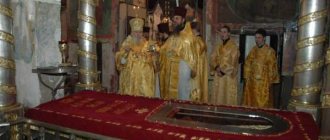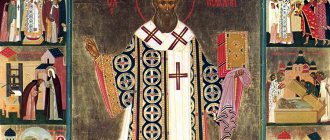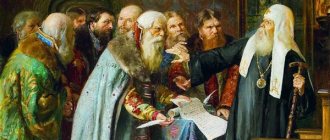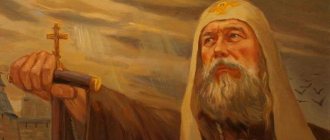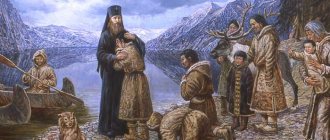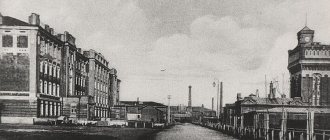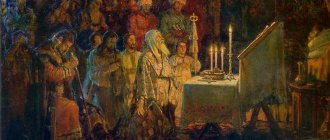Theognost (Guzikov): Biography
The future Archbishop Theognostus of Russia was born on October 6, 1960, into a simple family. That same year he was baptized in a local Orthodox church. The parents gave their son a name in honor of the Grand Duke of Kyiv and Chernigov Igor. The boy spent his childhood in the village of Selivanovo (now called Krasnaya Gorbatka).
Guzikov Igor Mikhailovich
Victim of Khan's greed
Like most major political and religious figures who lived during the period of the Tatar-Mongol yoke, Metropolitan Theognost was forced to periodically visit the Horde. He made such trips twice, and both times they were associated with severe mental and physical suffering.
Evil tongues informed Khan Janibek that the head of the Russian church receives huge income from his dioceses and, thus, has significant funds at his disposal. The Tatar ruler demanded that part of the wealth be given to him and subjected the bishop who objected to severe torture. Only a fair amount of self-control then allowed Theognostus to stay alive and prevent the church treasury from being devastated.
ROC
Since childhood, the hero of our article decided to devote himself entirely to the church and God. In the early 80s, he served in the Church of the Savior of the Image Not Made by Hands, which is located in the village of Spas-Zhelezino. After some time, he was a church minister in the Church of St. Nicholas, which is located in the city of Kirzhach.
Lord Theognostus
On November 22, 1983, Igor Guzikov was tonsured a monk by Archbishop Serapion of Suzdal and Vladimir. He was given a name in honor of St. Theognosta. This action took place in the bishop's chambers of the house church. In the spring of 1984, he became a monk at the Trinity-Sergius Lavra. Two years later, Igor Mikhailovich was elected to the rank of abbot and to the rank of archimandrite. On November 30, 1988, he became the viceroy of the same monastery. Since the 90s he has been a teacher at MDA. There the archbishop gives a course in patrolology.
Archbishop Theognost celebrated the Liturgy at the Butovo Polygon
On March 13, 2002, he was appointed vicar of the Moscow diocese, Bishop of Sergiev Posad, as well as the first bishop-vicar of the Trinity-Sergius Lavra in history. The next day, Archimandrite Theognostus was consecrated Bishop of Sergiev Posad. This action took place in the Cathedral of Christ the Savior. The consecration was performed by the Holy Patriarch Alexy, and seven metropolitans, four archbishops and three bishops were also involved. On February 15, 2004, the bishop arrived in Antarctica to consecrate Trinity Church on Waterloo Island, part of the South Shetland Islands.
Viceroy of the Trinity-Sergius Lavra Archbishop Theognostus
Saint Theognostus of Kiev and All Rus', Metropolitan
Brief life of Saint Theognostus, Metropolitan of Kyiv and All Rus'
Metropolitan Theognostus, successor to the Kyiv and Vladimir departments of Metropolitan Peter, was a native of Constantinople.
He was known as an expert in church canons. He chose Moscow as his place of stay in Rus', not wanting to “leave the tomb of the miracle workers,” that is, Metropolitan Peter, and, like him, was an assistant and firm support for the princes of Moscow. At that time he was leading. John Kalita, Prince of Moscow, became a prince in Rus'. Then silence fell in Rus', and the Principality of Moscow began to grow and strengthen. But Saint Theognostus had to endure a lot of hard things. Thus, when Prince Alexander of Tver, having incurred the wrath of Khan Uzbek, fled to Pskov, the saint was forced to close all the churches in Pskov. Then, feeling sorry for the Pskovites, Alexander fled to Lithuania, and only by this was a new Tatar invasion of Rus' prevented. When Prince Alexander returned to Rus', so as not to deprive the children of his family rights, and was executed with his son Theodore in the Golden Horde, Metropolitan Theognost met their bodies in Vladimir, buried them with tears and sent them to Tver (see Oct. 2, life St. Anna Kashinskaya). He reconciled Free Novgorod with the Moscow prince, and in 1346 (under the great prince Simeon Gordom, son of Kalita), Novgorod submitted to the prince by his will. to the prince. In 1342, Khan Janibek wanted to destroy all the rights and benefits of the Orthodox clergy and impose tribute on them, and force the metropolitan to collect this tribute, threatening otherwise to collect it himself. The Metropolitan gave all his property to the Tatars, but refused to take tribute from the churchmen, citing the words of the Apostle Paul: “If anyone destroys the temple of God, God will punish him, for the temple of God is holy; and this temple is you” (1 Cor. 3:17). He was tortured, but he did not yield, and then the khan confirmed all the rights and benefits of the Orthodox Church. When the Metropolitan returned to Moscow, a terrible fire, the fourth in his reign of the Russian Church, devastated Moscow, and the Metropolitan, despite the fact that he no longer had any funds left, began to restore the churches from the very next year.
Anticipating his death, he appointed Bishop Alexy of Vladimir (comm. February 12) as his successor. He traveled around his flock very often, from the very first year of his arrival in Rus'. In the last year of his life, the young hermit Bartholomew (the future St. Sergius - his memory is September 25) arrived in the Radonezh forests and turned to him for his blessing to create a church in the name of the Most Holy Trinity. The Metropolitan received him fatherly, blessed him and gave him the requested permission. Saint Theognostus fell ill in 1352, and died on March 14, 1353 and was buried in the Assumption Cathedral in the chapel of St. Apostle Peter, founded by him in memory of his predecessor.
In 1471, his holy relics were found incorrupt, and in 1474 a mute person received healing from them. He said that he saw the saint rise from the grave, blessed his tongue, after which the gift of speech returned to him. Saint Theognostus was canonized in the 19th century.
Complete Life of Saint Theognostus, Metropolitan of Kyiv and All Rus'
Blessed Theognostus, a Greek by origin, was born in Constantinople, while still a youth he acquired knowledge of divine canons and laws, proved himself to be a wise and God-loving man and was considered an adornment of his native city. He was installed as the metropolis of Kyiv and All Russia by Isaiah, Patriarch of Constantinople, in 1328 and then arrived in the Galicia-Volyn land, installed two bishops here, then proceeded first to Vladimir, then to Moscow, where he sat on the throne of his predecessor, the wonderworker Peter the Metropolitan, and began to live in his house.
In the same year, the Grand Duke of Moscow, John Daniilovich, traveled to the Horde, whose khan, named Uzbek, entrusted him with the great reign of Vladimir and sent him to Moscow with great honor. Since then, the Tatars stopped fighting with the Russian land, and there was silence in it for forty years. Saint Theognostus rejoiced at the rise of the Grand Duke of Moscow and in all cases was his firm assistant, since the Lord was pleased to move and establish the Kyiv and Vladimir powers in the God-loving city of Moscow. The next year after his arrival, the holy Metropolitan Theognostus took care of the beautification of the capital city of his metropolis, and built a stone church in Moscow in the name of St. John of the Climacus and created a chapel to the Church of the Dormition of the Mother of God in the name of St. Apostle Peter (worship to his honorable chains), thereby marking the veneration of the holy memory of his predecessor, Metropolitan Peter, who rests in this Assumption Church. In 1329, the blessed metropolitan set out from Moscow to inspect his vast flock. First of all, following the example of his predecessors Cyril, Maximus and Saint Peter, Saint Theognostus visited Novgorod. At this time, Alexander Mikhailovich Tverskoy reigned in Pskov, having taken refuge here from the Horde, where he killed the murderer of his father. Khan Uzbek urgently demanded that Alexander appear for trial in the Horde, but he did not dare to go to the Tatars. Knowing the fury of Khan Uzbek, who would not spare the Russian land for the disobedience of Alexander Mikhailovich, his brothers united with Grand Duke John Danilovich to force the Prince of Pskov to carry out the will of the khan. Neither Vladyka Moses nor the mayor, who arrived from Novgorod to Pskov, convinced the Pskovites to release Alexander to the Horde. Then his brothers and the Moscow prince approached Pskov with their troops and, in order to avoid the shedding of Christian blood, they begged the Right Reverend Theognostus to bind Prince Alexander by excommunication and prohibition and send him to the Horde. Saint Theognostus laid excommunication and a curse on the Prince of Pskov, on the entire city of Pskov and on their entire region.
Then Prince Alexander Mikhailovich said to the Pskovites: “Faithful brothers and friends! Let there be no excommunication and holy curse on you for my bad and sinful sake. I am leaving you for the Germans and Lithuania, so that there will be no burden on your land from the Tsar of Uzbek.” The Pskovites obeyed, released Alexander with tears and sent a petition for peace and love to Grand Duke John Danilovich. He reconciled with the Pskovites, and the Metropolitan gave them his blessing.
Having consecrated Bishop Anthony for Rostov and Yaroslavl, in place of the deceased Prokhor, the Right Reverend Theognost went in 1330 to the Galicia-Volyn region.
On the way here, or perhaps earlier than this journey, Saint Theognostus stopped in the city of Kostroma, where a council of four bishops was assembled, which installed Bishop Daniel on the Suzdal see, and then dealt with the dispute between the bishops of Sarai and Ryazan about Chervlen Yar (the area between the rivers Don and Khoprom). The matter was decided in favor of the Ryazan ruler: Chervleny Yar was assigned to the Ryazan diocese. He stayed in the Galicia-Volyn region for a long time to console Orthodoxy, which was strongly pressed by Catholicism, and in order to prevent the separation of the Galicia-Volyn bishoprics into a separate metropolis from the All-Russian metropolis. From Vladimir of Volyn, he sent word to Novgorod that Vasily, who had been named Archbishop of Novgorod, would appear to him for consecration. At the same time, ambassadors from the Pskovites, from the returning Prince Alexander of Tver and from Prince Gediminas of Lithuania, came to Vladimir, asking the Metropolitan to appoint a special bishop in Pskov - Arseny. Theognost installed Vasily as archbishop of Novgorod and Pskov, and refused the Pskovites’ request, since they sought a separate bishop out of a desire for church and civil independence from Novgorod, and shortly before this time they showed disobedience to the Grand Duke and Metropolitan. In Vladimir of Volyn, Bishop Theodore for Tver was consecrated by blessed Theognost.
Following the newly installed Archbishop Vasily, who was returning with the mayors and their squad to Novgorod, the Metropolitan sent a letter in which he wrote: “The Prince of Lithuania sent 500 soldiers against you to capture you.”
Vladyka Vasily and the mayors accelerated their journey, but near Chernigov they were overtaken by Prince Theodore of Kiev with the Tatar Baskak. They barely paid off their pursuers. God punished Prince Theodore’s squad for this by the fact that on the way back their horses fell and they walked on foot. And the blessed metropolitan shamed the prince, threatening: “Shame on the prince who commits injustice, offends, commits violence and robbery.”
Having visited Przemysl, Kholm and Galich, the high priest settled for a time in Kyiv to establish the ancient metropolis, which had suffered from the Mongols and Lithuania. Ambassadors from the Grand Duke of Moscow John Daniilovich came here to the Metropolitan so that he would give the prince a blessing to erect a church in the name of the Transfiguration of our Savior Jesus Christ, to build a monastery inside the city of Moscow and to transfer the archimandrite there from St. Daniel from Zarechye, for the Grand Duke wanted to install it inside the city , near his palace, so as not to be separated from this shrine day or night. The Right Reverend Metropolitan lovingly gave his blessing to the prince, and soon a stone church of the Savior was built on Bor, between the dwellings of the Grand Duke and the Metropolitan, and the Spassky monastery was founded.
From southern Russia, Metropolitan Theognostus went to Greece and the Horde. He visited the Patriarch in Constantinople to resolve the perplexities raised during the pastoral review of the dioceses, and reported to the council there about the miracles of Metropolitan Peter. In response to the last message, Metropolitan Theognost received in 1333 written permission from Patriarch John XIV Kaleki to celebrate the memory of the saint. His Grace Theognost visited the Horde in order to obtain approval of the rights and benefits granted to the Russian Church by the Tatar khans.
Upon returning to Moscow, the Metropolitan consecrated in the fall of 1333 the stone church created by the Grand Duke on Kremlin Square in the name of St. Archangel Michael, the future tomb of the princes of the Moscow family. Following this, on the advice of Blessed Theognost, the son of John Daniilovich, Simeon married the daughter of the Grand Duke of Lithuania Augusta, who was baptized in Moscow and named Anastasia. Wisely promoting the establishment of good relations between Lithuania and Rus', the blessed saint showed himself to be a peacemaker between Moscow and Novgorod.
Having ordained Bishop Gabriel for Rostov in 1336, the high priest confirmed Prince Alexander Mikhailovich of Tver's intention to go to the Horde with submission to the Tatar Khan. Having accepted the blessing from Metropolitan Theognostus and from all the Russian saints and deciding that it was better to die for the faith than to bring the wrath of the Tatars to all of Russia with his disobedience, Prince Alexander went to the Horde and humbly surrendered himself to the will of Khan Uzbek. He marveled at his wisdom, granted him the reign of Tver and released him to Rus'. But soon the Tver prince was slandered in the Horde, he was summoned there a second time with his son Theodore, and both were killed by order of Uzbek. Their bodies were met in Vladimir by Metropolitan Theognostus with a sacred cathedral, sang funeral hymns over them and released them with tears to Tver. In the winter of 1340, Metropolitan Theognost was in Bryansk. Under him, sedition arose against Prince Gleb Svyatoslavich. In vain did the saint persuade the indignant Bryansk residents - they did not listen and killed the prince.
At this time, Ivan Daniilovich Kalita died; his son Simeon Ioannovich sat on the throne of the great reign of Vladimir and Moscow. He sent to Torzhok for tribute. But the residents of Torzhok turned to Novgorod with a complaint against the Moscow boyars who were collecting tribute. The Novgorodians captured them and imprisoned them for a while. The angry Grand Duke Simeon went with his army to Torzhok. The Novgorodians were seized with fear, and they begged the Metropolitan, who was in the army, to grieve for them before the prince. The High Hierarch persuaded the prince to make peace with the Novgorodians and visited Novgorod, where with his teachings he restrained the violent inhabitants from robbery and violence.
In 1342, Grand Duke Simeon Ioannovich went to the Horde to visit the new Khan Dzhanibek, he was accompanied by His Grace Metropolitan Theognost. After staying in the Horde for a short time, the Grand Duke returned to Moscow. The Holy Hierarch of God Theognost remained in the Horde, since he was slandered before the khan by some villains from the Russians, who said: “Metropolitan Theognost does not give tribute to the Horde from the consecrated rank and from the entire church clergy, but he himself collects countless tributes from them, but you , Khan, offends, and he should give you tribute to the Horde every year.”
The Khan demanded from the Metropolitan that he present him with an annual tribute. Saint Theognostus did not obey this order. To the Tatars’ coercion and questions as to why the Metropolitan did not want to give church tribute, the saint answered: “Christ, our true God, redeemed His Church from the infidels with His honest blood, therefore the church clergy is free from all slavery and service, except for serving God. And why are you making me answer you for this tribute?”
The infidels said to this: “You are the head of the Churches and you must either give us an annual tribute for them, or allow us to collect tribute from them ourselves, we will not spare anyone.”
The saint answered: “If anyone insults the Church of God, God will insult him. This is what our teacher Paul, the apostle of Christ, writes.”
The filthy ones did not cease to force the saint to submit tribute, threatening him with all sorts of torments, but they themselves did not dare to collect tribute from the clergy and clergy. God did not allow their insolence to appear and frightened them. For they knew that their first kings, being wicked, unmerciful and bloodsuckers, gave, however, orders confirmed by oaths to the metropolitan and bishops not to take tribute from any of the church clergy and from all those living in the regions belonging to the Church, all their khans They were considered God's servants and brought this tribute to the Heavenly God. And to this day such letters (labels) of wicked kings have been preserved, supported by terrible oaths, written to the great wonderworker Peter, Metropolitan of All Russia, and other metropolitans. Many times the khans tried to break their oath and themselves, without the permission of the metropolitan, wanted to collect an annual tribute from the church clergy, but the Supreme Providence forbade them to do this, for they were afraid of God's execution.
The wicked Tatars greatly tormented Christ's saint Theognostus, forcing him to remove their previous oath and allow them to collect tribute from the church clergy. The blessed sufferer Theognostus valiantly endured these torments for the sake of the Church of Christ. He did not care about his property and then distributed up to 600 silver rubles to the Tatars. But he not only did not allow the Tatars to collect tribute from church people, but completely forbade them to do so and swore them with terrible oaths. He was released to Rus' with the same rights of the clergy, and Khan Taidul’s wife confirmed them with a special letter. Thus the saint freed the Church of Christ from misfortune, and the clerks from taxes and tribute. Like an invincible warrior, Saint Theognostus returned with victory and, at the very center of Holy and Great Lent, he arrived safely at his throne of the Russian Metropolis, bringing thanksgiving to God and the Most Pure Mother of God.
Soon after returning from the Horde, the saint was distressed by the terrible fire that devastated Moscow and destroyed up to 18 churches. This disaster was all the more painful because the fire of 1343 was already the fourth under Blessed Theognostus, and meanwhile so many expenses were made in the Horde. And, however, the zealous archpastor the next year instructed Greek artists to resume the icon painting in his cathedral church of the Most Pure Mother of God, and the renewal was completed that same year.
After the death of Grand Duke Gediminas (in 1341), bloody strife arose in Lithuania between his sons. One of them, Evnutius, was forced to flee Lithuania and came to Moscow. Here the pagan prince was baptized by the metropolitan in 1345 and named John. Following this (1346), Vladyka Vasily of Novgorod arrived in Moscow with an offer to Grand Duke Simeon to take the throne of the Novgorod reign. Immediately upon arrival, he visited the Metropolitan, brought him gifts and asked for a blessing. The High Hierarch blessed Vasily and honored him with cross-shaped vestments. At the same time, the Metropolitan installed Spassky Archimandrite John as bishop of the city of Rostov.
It so happened that the Patriarch of Constantinople elevated the Galician bishop to the rank of metropolitan of all southern Russia, thus creating a metropolis separate from the Kyiv one, this caused a lot of unrest in church administration. Due to the appointment of a special metropolitan for southern Russia, Blessed Theognostus had to experience many anxieties. After a consultation with the Grand Duke of Moscow, ambassadors were sent to Constantinople, and the saint’s concerns were not fruitless. The Council of Constantinople in 1347 decided to destroy the previous definition of the Galicia-Volyn Metropolitan and honored Theognostus with the title of “preferred metropolitan and exarch of all Rus'.”
Delighted by this decision of the Council of Constantinople, Blessed Theognostus went to Volhynia the following year. Following his return to Moscow, the Volyn prince Lyubart Gediminovich, in Holy Baptism, Theodore, sent to the Grand Duke of Moscow to ask for his marriage the niece of the Grand Duke, the daughter of the Rostov prince. On the advice of the Right Reverend Theognost, the Rostov princess was willingly married to Lubart, who was zealous for the holy faith. Then Olgerd, the Grand Duke of Lithuania, sent ambassadors to Simeon Ioannovich with a request to marry Juliana, the daughter of Prince Alexander of Tver. The Grand Duke of Moscow had doubts about marrying his relative to a pagan and asked the Metropolitan for advice. The High Hierarch, bearing in mind the beneficial consequences of this marriage, both for the state and especially for the success of the holy faith in pagan Lithuania, gave a blessing for the marriage (1350).
Weakened by years and labors, blessed Theognostus was seriously ill at the end of 1350. Humbly enduring his illness, the high priest did not abandon his pastoral ministry, returned Bishop Daniel to the Suzdal see, and also installed Bishop Moses for the second time in Novgorod. In 1352, Russia was visited by a terrible misfortune: a pestilence opened and devastated many Russian regions. The elderly saint went through a difficult year, preparing for death. In winter, the Right Reverend Theognostus installed his deputy, Saint Alexis, whom he loved, as bishop of the city of Vladimir. Thus, during his lifetime, the Metropolitan made him ruler, and after his death he blessed him in his place, in the metropolitanate of Kyiv and all Russia. Saint Theognostus was distinguished by his outstanding intellect and extensive theological knowledge. Zeal for Orthodoxy prompted the saint to speak out against those who wrongly teach about the Divine light. Saint Theognostus left behind written works. Of these, a teaching was recently found under the following title: “The teaching of Theognostus, Metropolitan of All Rus', is soul-helping and saving. To our spiritual children, faithful Christians, from the Divine Scriptures about the love of humility, that it is not proper for Christians to play and laugh disorderly, that those who unworthily come to the Divine Mysteries plunge themselves into unbearable torment, and about how it is proper to honor the Honest and Life-giving Cross of the Lord.”
In 1353, on March 11, blessed Theognostus, the great Russian shepherd and mentor, departed in peace to the Lord, and labored diligently for his sake. All the years of his priesthood were 25. On March 14, the venerable body of the blessed one was laid in the glorious city of Moscow, in the great cathedral church of the Most Pure Mother of God, in the chapel of the Adoration of the chains of the Supreme Apostle Peter, near the miraculous tomb of Peter the Metropolitan, the God-bearing Russian saint. The relics of St. Theognostus, found incorrupt in 1471, did not rest long in this cathedral church, which had already become dilapidated, having existed for 146 years. The Grand Duke of Moscow John III Vasilyevich and Metropolitan Philip planned to build a new temple on the site of the old one, similar to the Church of the Most Holy Theotokos in Vladimir, and transfer the relics of the holy metropolitans there. In 1474, the new temple was destroyed, and on March 10, 1475, the relics of the holy metropolitans, including St. Theognostus, were transferred to the church of St. John, to the bells. The new Church of the Assumption of the Blessed Virgin Mary was completed in 1479 under Metropolitan Gerontius, and the shrines of the holy metropolitans were solemnly transferred there on August 27. The relics of Metropolitan Theognostus were placed in the old way, and here they still rest in secret.
In 1474, a glorious miracle took place at the tomb of St. Theognostus. A certain man in the city of Moscow went, according to custom, to the place of the poor, where citizens buried wanderers and beggars. There was a custom to visit this place on Thursday of the seventh week, bring eve and candles there and pray for the dead. That man went along with everyone else. And so they began to fill up the old hole, which was filled with dead bodies, and dig a new one. And all the citizens, men and wives, dug and covered it with earth, for God’s sake. And that man took the earth from the new hole in the floor and carried it into the old one, but due to crowded conditions, he stumbled, fell to the ground and suddenly became deaf and numb. He suffered from this illness for many days; Once someone said to him, as if in a dream: “Go tomorrow to the cathedral church of the Most Pure Mother of God, in honor of Her glorious Dormition.” He went there and began to venerate the tombs of the holy metropolitans Peter, John and Philip; when he venerated the tomb of Saint Theognostus, he suddenly began to speak and hear, and told everyone how dumb he was and how his speech returned: “When I bent down,” said the healed man, “and wanted to venerate the relics of Saint Theognostus, the saint suddenly stood up , blessed me with his hand and touched my tongue. I stood there as if dead and suddenly began to speak.” Those who heard this marveled and glorified God and the holy Metropolitan Theognostus.
In the 16th and 17th centuries, Saint Theognostos became one of the venerated dead. Local celebration was established for him in the 19th century. Currently, a church-wide celebration is being held for St. Theognostus. With the blessing of His Holiness Patriarch Kirill of Moscow and All Rus', on March 6, 2022, the name of the holy Primate of the Russian Orthodox Church, Metropolitan Theognostus, was also included in the Council of Moscow Saints.
See also:
- Metropolitan Theognost prof. HER. Golubinsky
- Saint Theognostus, Metropolitan of Kiev and Vladimir Monastery. Taisiya (Kartsova)
- Theognostus, Saint, Metropolitan of Kiev and All Rus'. Manuil (Lemeshevsky)
Feognost Guzikov now
On April 20, 2009, Theognost was elevated to the rank of archbishop; this happened in the Assumption Cathedral of the Trinity-Sergius Lavra. On March 5, 2010, Guzikov became the honorary chairman of the synodal commission, which deals with the affairs of monasteries. In June of the same year, the hero of our article was appointed to act as general director of the Sergiev Posad State Museum-Reserve. On March 22, 2011, he was admitted to the ranks of the Supreme Church Council of the Russian Orthodox Church.
On duty
Igor Mikhailovich is an amazing person and a devoted novice of God.
For his hard work, on December 14, 2008, he was awarded the Order of St. Equal to the Apostles Grand Duke Vladimir of the second degree. For his diligent service and in connection with his fiftieth birthday, the Archbishop was awarded the Order of St. St. Seraphim of Sarov, second degree, and five years later on the same date he was awarded the Order of St. Innocent, second degree. On May 14, 2016, for his enormous contribution to the development of cultural and spiritual ties, Igor Guzikov was awarded the Order of Friendship. He graduated from high school in 1978 and served in the army from 1979-1981. In 1987 he graduated from the Moscow Theological Seminary. In 1991 he graduated from the Moscow Theological Academy with a candidate's degree in theology for the essay “Pastoration according to the teachings of the Orthodox Church.”
Protege of the Patriarch of Constantinople
No documentary information has been preserved about the birth and early years of the life of the venerable archpastor. It is only known that by his origin he was Greek, and in his youth he took monastic vows, which can be judged not from biographical data, which is very meager, but from his own words that one can occupy the highest church post only after passing through all full lengthy monastic experience.
The earliest chronicle information about him dates back to 1328, and they are associated with the move of Metropolitan Theognostus to Moscow, where he was sent by Patriarch Isaiah of Constantinople. It is known that at that time Byzantium was rapidly approaching its decline, and, paying special attention to personnel policy, the head of the church, who was also the Ecumenical Patriarch, tried to stop this process.
Archpastoral concerns of the venerable Metropolitan
Despite all the worries of the vain world, the main area of activity of Metropolitan Theognostus always remained his archpastoral ministry, aimed at centralizing and streamlining church power. In this regard, he carried out a lot of work to eliminate independently established metropolises, such as Lithuanian, Galician and a number of others.
On the initiative of Theognost, his predecessor at the Moscow See, Metropolitan Peter, was canonized and glorified as a saint, and an outstanding literary monument of that era was compiled - the Siya Gospel, which is stored today in the collections of the library of the Russian Academy of Sciences.
